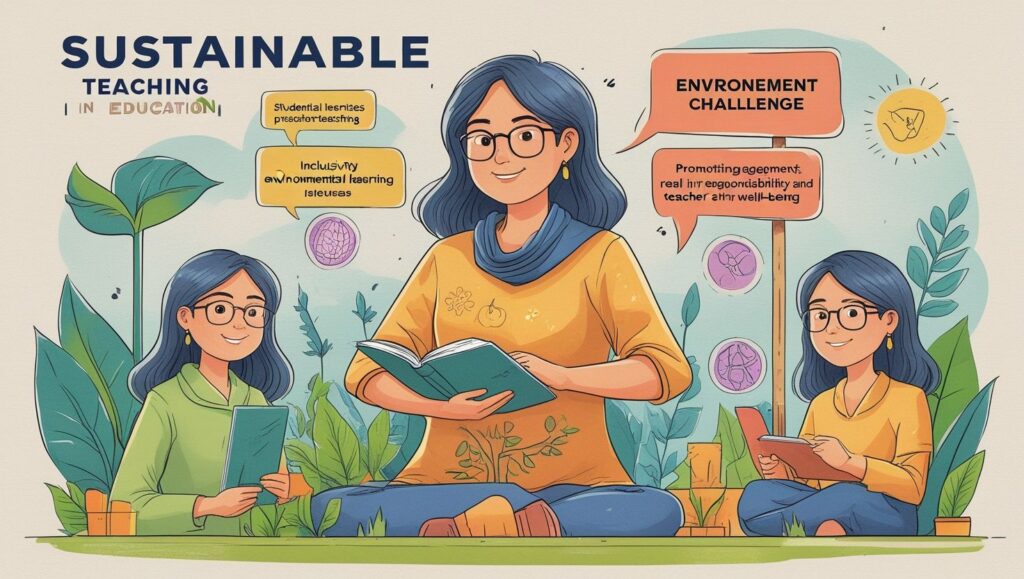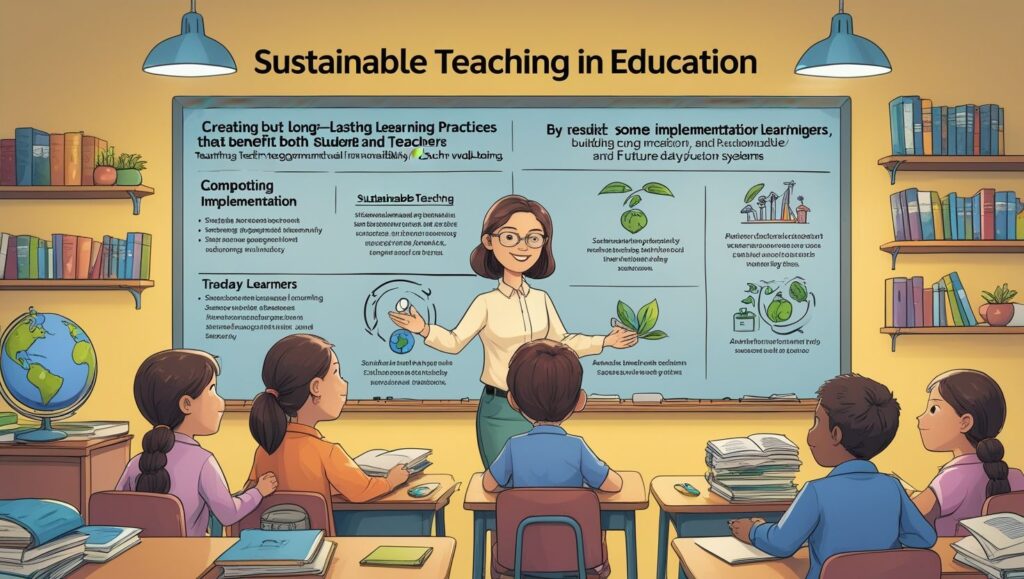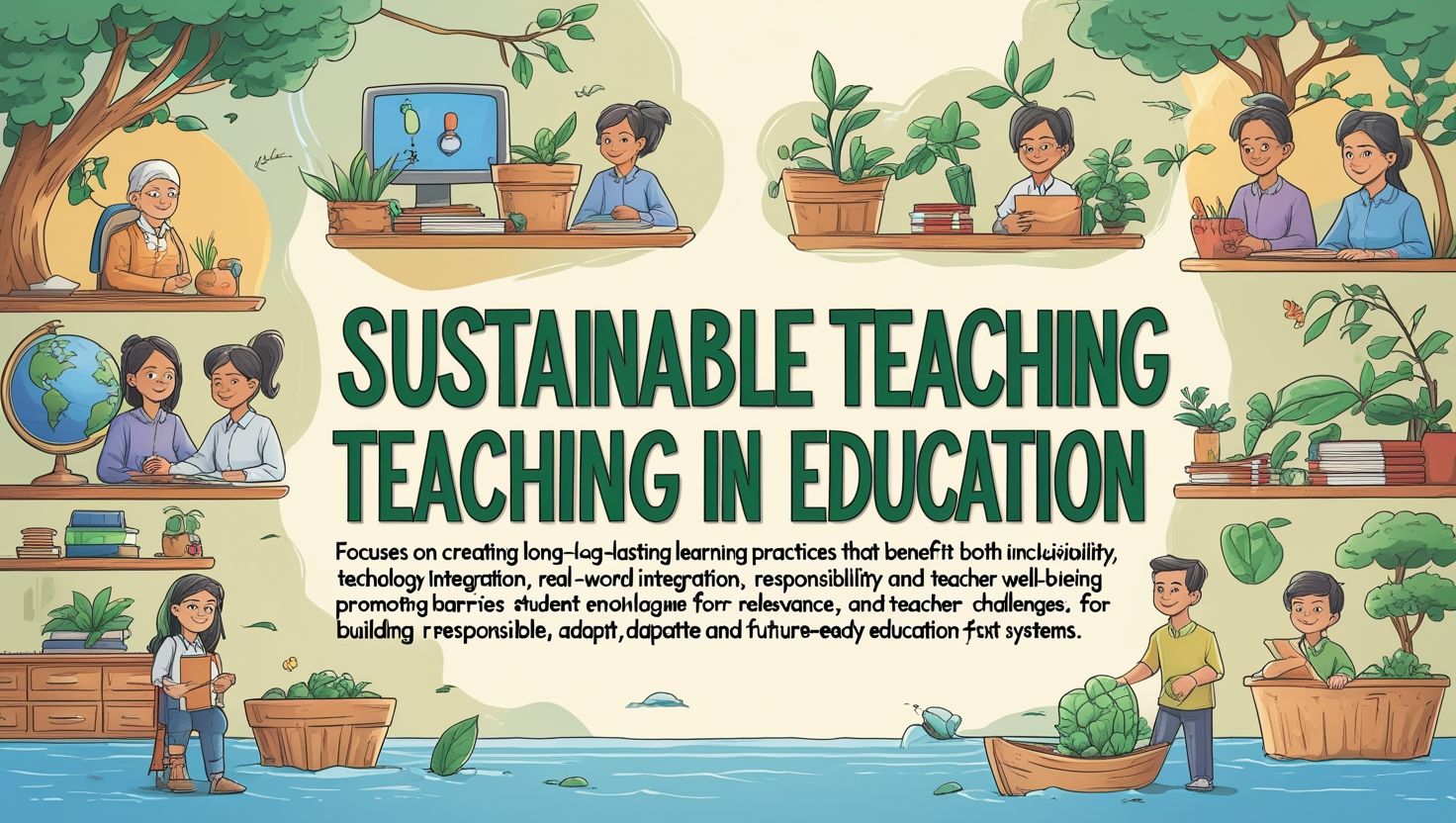Introduction
Sustainable Teaching in Education, Sustainable teaching in education is becoming an essential approach in today’s world. It focuses on creating long-lasting learning environments that benefit students, teachers, and communities. Unlike traditional teaching, it emphasizes strategies that balance academic success, social responsibility, and environmental awareness. Teachers who adopt sustainable methods prepare students not only for exams but also for real-life challenges. They integrate modern tools, inclusive practices, and innovative pedagogy to achieve long-term results. In addition, sustainable teaching ensures that learning continues to evolve with changing times and technologies. This approach also values the well-being of teachers, recognizing that their energy and motivation directly impact classroom success. Therefore, sustainability in teaching is not just about environmental aspects but about building a system that supports continuous growth, equity, and resilience in education. It prepares learners for a brighter and more responsible future.
Importance of Sustainable Teaching
The importance of sustainable teaching in education cannot be overstated. It ensures that educational practices remain relevant, effective, and adaptable for future generations. Today’s world is rapidly changing, and outdated teaching methods often fail to engage students. By adopting sustainable teaching, educators bridge this gap and foster lifelong learning. Additionally, sustainability encourages practices that are inclusive and equitable, reducing educational disparities. It also allows teachers to prioritize student-centered learning, which nurtures creativity, problem-solving, and collaboration. Moreover, when teachers adopt sustainable methods, they reduce stress and burnout by using strategies that balance workload and efficiency. Schools that focus on sustainability also develop strong community connections, helping learners understand their responsibilities in a global context. Ultimately, sustainable teaching provides the foundation for educational systems to thrive. It combines innovation with stability, ensuring both present needs and future demands are met.
Key Principles of Sustainable Teaching
Several principles guide sustainable teaching in education. First, it emphasizes equity, ensuring that every student, regardless of background, has access to quality learning. Second, it highlights collaboration, encouraging both teachers and students to work together for collective success. Third, it focuses on relevance, connecting lessons to real-world issues such as climate change, diversity, and digital literacy. Another principle is adaptability, where teachers continuously adjust strategies to meet evolving student needs. In addition, sustainable teaching promotes the integration of technology while maintaining balance with traditional approaches. It also values teacher well-being, recognizing that motivated educators create better learning environments. Furthermore, sustainability involves developing critical thinking and problem-solving skills that go beyond textbooks. These principles are interconnected and support a holistic learning system. By applying them consistently, schools foster an atmosphere that nurtures growth, innovation, and responsibility for both present and future generations.

Sustainable Teaching and Student Engagement
Student engagement is one of the main goals of sustainable teaching. Engaged learners actively participate in their education, which leads to better understanding and retention of knowledge. Sustainable teaching achieves this by using innovative strategies, such as project-based learning and technology integration. It also connects classroom content with real-life examples, making lessons more meaningful. Moreover, sustainable teaching promotes inclusive practices, ensuring that every student feels valued and involved. Teachers use active learning techniques, such as discussions and group work, to maintain interest. Furthermore, this approach encourages curiosity and creativity, which help students become independent learners. By creating a supportive classroom environment, sustainable teaching also builds student confidence. It emphasizes collaboration over competition, motivating learners to support one another. As a result, students are more motivated, enthusiastic, and prepared to face future challenges. Thus, sustainable teaching directly enhances student engagement and long-term learning outcomes.
Teacher Well-being in Sustainable Teaching
Sustainable teaching is not only about students; it also prioritizes teacher well-being. Educators often face heavy workloads, stress, and burnout, which can negatively affect classroom performance. Sustainable practices help address these challenges by promoting balanced teaching strategies. For example, collaborative planning and resource sharing reduce individual burdens. Moreover, integrating technology can simplify tasks such as grading and lesson preparation. Sustainable teaching also encourages professional development, allowing teachers to continuously update their skills. Additionally, it emphasizes emotional well-being, reminding educators to maintain a healthy work-life balance. When teachers feel supported, they become more motivated and effective in guiding their students. Furthermore, schools that adopt sustainable practices foster a culture of respect and care. This creates a positive environment where both teachers and learners thrive. In conclusion, prioritizing teacher well-being is a key element of sustainable teaching, ensuring long-term success in education systems.
Role of Technology in Sustainable Teaching
Technology plays a crucial role in sustainable teaching by making learning more interactive, flexible, and accessible. Online platforms, digital resources, and multimedia tools provide students with multiple ways to learn. They also reduce the overuse of paper, contributing to environmental sustainability. Additionally, technology supports inclusive education by offering tools for students with different needs. Teachers can use digital assessments to track progress efficiently, saving time and effort. Moreover, technology enables remote and hybrid learning, ensuring that education continues during disruptions such as pandemics. However, sustainable teaching does not mean relying entirely on technology. Instead, it promotes a balanced approach that combines digital tools with traditional teaching methods. This ensures that students develop both technical and interpersonal skills. When used wisely, technology enhances collaboration, critical thinking, and creativity. Therefore, it serves as an essential driver of sustainable teaching in modern education systems.

Sustainable Teaching and Inclusive Practices
Inclusive practices are at the core of sustainable teaching. Every student deserves equal opportunities to learn, regardless of background, ability, or social status. Sustainable teaching ensures that classrooms are supportive and adaptable to diverse needs. Teachers use differentiated instruction, which adjusts methods according to individual learning styles. Moreover, they integrate culturally relevant materials, helping students connect with lessons. Inclusive classrooms also promote respect, tolerance, and collaboration among learners. Additionally, technology provides tools like text-to-speech software and visual aids, making education more accessible. Sustainable teaching further emphasizes emotional inclusion by creating safe spaces where students feel valued. Teachers also receive training in diversity awareness, enabling them to address biases effectively. Such inclusive practices not only improve academic outcomes but also prepare students for a diverse world. Ultimately, sustainable teaching strengthens education by embracing inclusivity, ensuring no learner is left behind.
Environmental Responsibility in Teaching
Sustainable teaching goes beyond academic practices; it also incorporates environmental responsibility. Schools play a vital role in promoting eco-friendly behaviors among students. Teachers can integrate environmental topics into their curriculum, raising awareness about issues such as climate change, waste reduction, and renewable energy. Additionally, schools can adopt practices like recycling, reducing paper use, and conserving energy. Sustainable teaching also encourages outdoor learning, which helps students connect with nature. Moreover, eco-friendly projects, such as planting trees or creating school gardens, teach responsibility and teamwork. By modeling environmentally conscious behavior, teachers inspire students to adopt sustainable habits in their own lives. Furthermore, environmental responsibility fosters critical thinking, as learners explore solutions to global challenges. Thus, sustainable teaching not only educates but also empowers students to become responsible global citizens. It creates awareness that education and environmental care are deeply interconnected.

Challenges in Implementing Sustainable Teaching
Although sustainable teaching offers many benefits, implementing it comes with challenges. One major obstacle is the lack of resources, as many schools struggle with limited budgets. Teachers may not have access to technology, training, or modern facilities. Additionally, resistance to change can hinder progress, with some educators preferring traditional methods. Another challenge is balancing curriculum requirements with innovative teaching strategies. Furthermore, teachers often face time constraints, making it difficult to integrate new approaches. Professional development opportunities are also limited in some regions, reducing teachers’ ability to adopt sustainable practices. Moreover, socio-economic inequalities affect students’ access to technology and learning materials. Despite these barriers, sustainable teaching can still succeed with proper planning and support. Governments, schools, and communities must work together to address these challenges. By doing so, they ensure that sustainable teaching becomes a practical reality in all education systems.
Future of Sustainable Teaching
The future of sustainable teaching looks promising as education continues to evolve. With advancements in technology, more tools will become available to support interactive and inclusive learning. Additionally, global awareness of sustainability is increasing, pushing schools to adopt eco-friendly and socially responsible practices. Teacher training programs will also focus more on sustainability, equipping educators with the skills needed for modern classrooms. Moreover, student-centered approaches will dominate, making education more personalized and relevant. Collaboration between schools, governments, and communities will strengthen the implementation of sustainable practices. Furthermore, innovations like artificial intelligence and virtual reality will enhance learning experiences while promoting efficiency. As challenges such as climate change and digital divides persist, sustainable teaching will play a crucial role in addressing them. Ultimately, the future of education will rely on sustainability to balance progress with responsibility, creating resilient learning environments for generations ahead.
Conclusion
Sustainable teaching in education is essential for building resilient, inclusive, and future-oriented learning systems. It balances academic success, teacher well-being, student engagement, and environmental responsibility. By integrating technology, promoting inclusivity, and encouraging collaboration, sustainable teaching ensures that education remains relevant and effective. Although challenges such as limited resources and resistance to change exist, collective efforts can overcome them. The future of education depends on sustainable practices that prepare learners for a rapidly changing world. Teachers, schools, and communities must work together to implement these strategies effectively. In doing so, they not only improve educational outcomes but also nurture responsible citizens. Sustainable teaching is therefore not just an approach but a necessity for long-term success. By prioritizing sustainability, education can empower students to create a better, fairer, and more responsible future for all.
References
- Sterling, S. (2012). The Future Fit Framework: An introductory guide to teaching and learning for sustainability. Higher Education Academy.
- UNESCO. (2017). Education for Sustainable Development Goals: Learning Objectives. United Nations Educational, Scientific and Cultural Organization.
- Barth, M., Rieckmann, M., & Thomas, I. (2021). Implementing Sustainability in Higher Education: Learning in an Age of Transformation. Routledge.
